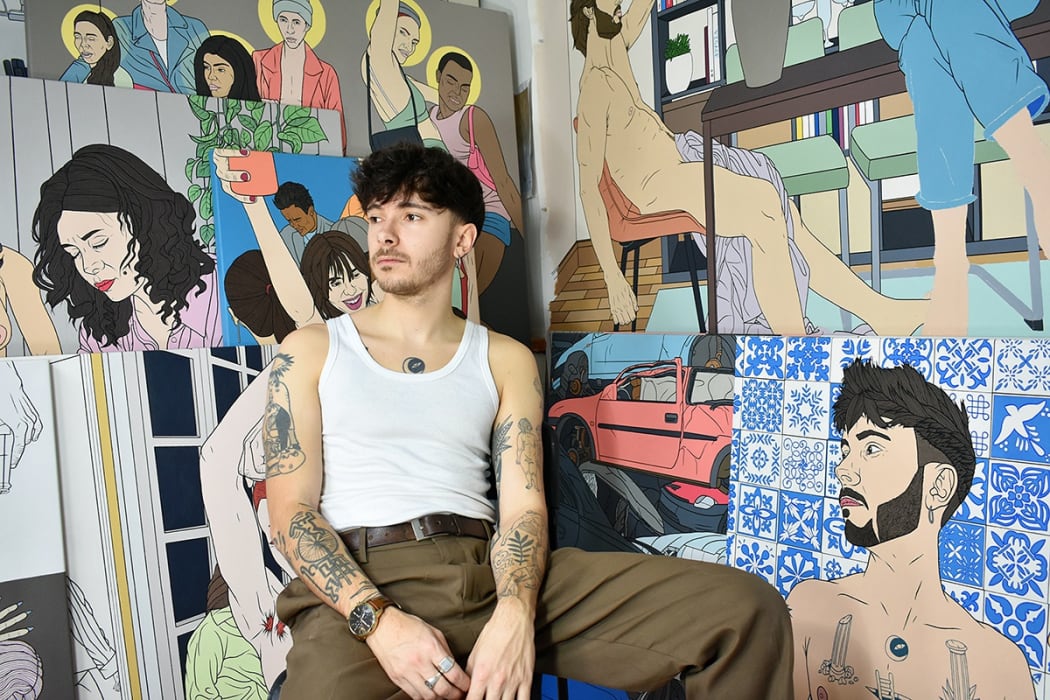
WE ARE PLEASED TO OFFER YOU THIS INTERVIEW WITH FRENCH ARTIST JULIAN SEMIAO ON THE OCCASION OF HIS FIRST EXHIBITION WITH THE GALLERY, "PERSONAL MYTHOLOGIES", WHICH OPENS ON MAY 27, 2023 IN PARIS. THIS IS AN OPPORTUNITY TO DISCOVER THE UNIVERSE OF THIS ARTIST WHO LIKES TO PORTRAY THE PARISIAN YOUTH, IN ALL ITS STRUGGLES AND CELEBRATIONS.
What was your childhood and adolescence like and what was your relationship to art and culture?
I grew up in a small village in the heart of the Beaujolais region, surrounded by vineyards, in the suburbs of Lyon. I spent my childhood and my adolescence between the culture and the abundance of the city and the calm of the countryside. I naturally took the path of art from the beginning of my school career. I have always been immersed in culture and I have traveled a lot with my family. My mother, who is passionate about art and theater, made me discover museums all over the world.
How did you get to Paris?
I arrived in Paris in 2017 to finish my studies with a master's degree in art at the Sorbonne. My apartment was in the heart of the Latin Quarter, between the Pantheon and Notre Dame, and I immediately fell in love with this festive and historic neighborhood where hundreds of students gather every night. I still go out a lot there and in the 11th arrondissement because I also love the gastronomy. Paris and its nightlife also feeds my work a lot.
In 2020, your work formally shifted from a form of expressionism to a purification of forms, what was your path?
In 2020, shortly after graduation, I needed to take my practice elsewhere. How to purify it? To go to the essential? Naturally, I wanted to focus on a more narrative form; the rage of expressionism gave way to the precision of a calmed and committed figuration, and my colors gradually softened.
Then, when I left covid, I took a studio that contributed to this new impetus in my practice. This new series of paintings that I did in 2022 and 2023 for Personal Mythologies is the result of a real achievement for me, the fruit of several years of research. I also moved several months ago to a new studio in Ivry-sur-Seine, much larger than the previous one and much calmer. It gives off a serene energy that helps me find inspiration. For me, feeling good in my work place has an important part to play in the creative process.
How would you describe your artistic practice today?
In my quest for a certain purity, I turned to the flat color and to the line. The figuration then depends on the precision of an outline and not on the shading as in figurative oil painting for example. This way came to me naturally, inspired by the painters of the Figuration Narrative of the 80s, Combas in the first place.
Today, figurative painting is in full expansion, from New York to Shanghai via Paris, with a new wave of talented young artists such as Chloé Wise, Bilal Hamdad, Arnaud Adami, Thomas Lévy-Lasne or Jean Claracq. They are a real source of inspiration for me. And as I am also passionate about classical painting, especially the Italian Renaissance, I stroll a lot in museums to be inspired by the great masters and their mastery of composition.

The subjects present in this new exhibition refer to several great paintings while being anchored in contemporary society where you talk to us about feminism, parties, queer culture and revolution!
I am a young Parisian living with the times. My parties and my life reflect a city where the queer community can express itself freely. I want to portray an open society, strong of its communities and its cultural differences. And I do indeed like to see myself as a feminist. I grew up and still live today surrounded by strong, independent women. Their struggle is also mine and I will do anything to support them. My paintings, almost in spite of myself, I think, reflect this. They are inspired by the people I meet and the woman is not just represented as a decorative muse. She is strong, rebellious and claims her egalitarian place in a world thought by men. The protagonist models of my paintings are my friends. I put them in scene to create new narrations in which they become actors of a new life which does not belong to them any more. They are inscribed in party scenes, but also in interior scenes that question the intimacy and the narrative of life of each individual, in a closed interior space.



